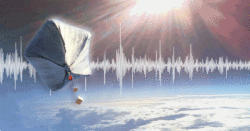Unexplained sounds have been captured by data capture balloons released into the Earth’s stratosphere by geophysicists (Picture: Sandia National Laboratories)
A science project using solar-powered balloons to explore the acoustics of the stratosphere has captured some mysterious sounds.
The noises were recorded at around 70,000ft by US researchers who made the $50 (£40) floating devices from tape, painter’s plastic and charcoal dust.
The stratosphere contains a rich ‘sound channel’ as it is a relatively calm layer of the Earth’s atmosphere rarely disturbed by aircraft or turbulence.
The infrasounds, which lie in the field of geo-acoustics, are inaudible to the human ear. However natural ‘whispers’ such as colliding ocean waves and thunder and those created by humans such as wind turbines and explosions have been teased out in recordings.
Daniel Bowman and his collaborators at Sandia National Laboratories, a US government contractor, built balloons that spanned between six and seven meters to capture the low-frequency sounds.
He said ‘The sounds of the stratosphere have not been investigated in half a century. Our initial motivation was simple curiosity. What is up there?
‘How is it different from ground-based recordings? Are there phenomena that can be recorded only in the stratosphere or only on the ground?’
A solar-powered hot air balloon taking flight with sensors including a GPS tracker and reusable infrasound sensor (Photo courtesy Sandia National Laboratories)
The eavesdropping devices are made from plastic bags, painter’s plastic and shipping tape with some charcoal dust on the inside.
When the sun shines on the dark balloons, the air inside heats up and becomes buoyant, the geophysicist explained.
‘This passive solar power is enough to bring the balloons from the surface to over 20km [66,000ft] in the sky,’ he said.
‘Each balloon only needs about $50 worth of materials and can be built in a basketball court.’
To view this video please enable JavaScript, and consider upgrading to a web
browser that
supports HTML5
video
The floating listening posts also contain microbarometers, which detect low-frequency data and were originally designed to monitor volcanoes.
GPS is used by the researchers to track the balloons, which can sail for hundreds of miles and sometimes land in hard-to-reach places.
The advantage of using relatively low-tech kit is that they can release numerous flights and collect data without too much worry about costs.
A view of the Earth from one of Sandia National Laboratories’ solar-powered hot air balloons. The photo was taken in July 2022 at a height of about 13 miles (Photo courtesy of Guide Star Engineering LLC)
In audio provided by the project — where 12 days’ worth of sound has been compressed into a few minutes — the sighing noise is infrasound from colliding ocean waves while the rustling sounds are unexplained.
‘The audio recording is from 2016, and I usually use more technical means of evaluating sounds such as spectral analysis,’ Daniel said.
‘It’s been nice to return to that recording and actually listen to it.
‘The sound of the ocean microbarom [infrasonic wave] is beautiful, and hearing all those other rustlings and rumblings reminds me that we still have a lot to learn.’
Researchers at the laboratories, which have their main facility in Albuquerque, New Mexico, have described geoacoustics as ‘whispers from Earth, sea and sky’.
An image of Earth from a solar balloon over North Carolina at an altitude of 22km (Picture: Daniel Bowman and Xiao Yang)
‘The most exciting part of the data collection is teasing out the sources of various sounds, and how they travel differently,’ Daniel said.
‘For example, my colleague Sarah Albert was able to use this technology to prove the existence of a “sound channel” in the sky that had been theorised way back in the late 1940s, but never proven until she came along.
‘It was neat to finally identify signatures from wind turbines and thunder a few years back, for example.’
Danny Bowman and Sarah Albert display an infrasound sensor and the box used to protect the sensors from extreme temperatures (Picture: Randy Montoya)
Intriguingly, the unexplained infrasound signals occur a few times per hour on some flights, which go twice as high as commercial flights fly.
‘As for the mystery sounds, the working hypothesis, which dates back to the 1960s, is that they are acoustic emissions from turbulence.
‘However, they could also come from meteors burning up in the atmosphere or distant severe storms or other sources. We really don’t know.’
The practical uses of the solar-powered balloons could include helping to explore other planets from a distance, such as observing Venus’s seismic and volcanic activity through its thick atmosphere.
Bowman gave a presentation of his findings at the 184th Meeting of the Acoustical Society of America in Chicago on Thursday.
To view this video please enable JavaScript, and consider upgrading to a web
browser that
supports HTML5
video
Last month, NASA launched a project encouraging the public to listen in and identify the sounds of space including recordings of plasma waves, a soup of charged particles between the Earth and Sun.
The HARP [Heliophysics Audified: Resonances in Plasmas] project asks people to pick out interesting aspects on the premise that the human ear can be a better decoding device than computers.
‘The human sense of hearing is an amazing tool,” said HARP team member Martin Archer of Imperial College London.
‘We’re essentially trained from birth to recognize patterns and pick out different sound sources.
‘We can innately do some pretty crazy analysis that outperforms even some of our most advanced computer algorithms.’
Do you have a story you would like to share? Contact [email protected]
Sounds inaudible to human ear are described as ‘beautiful’ by researcher who is tracing their origins.





